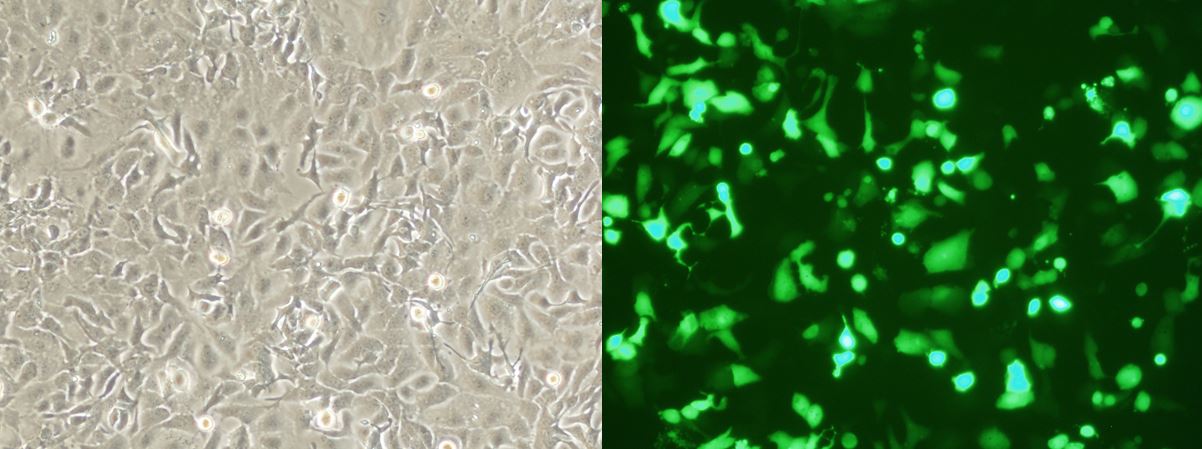Description
Cells to transfect:
Cell Line Name: OVCAR-5, OVCAR.5
Cell Synonyms: NCI60, NCI-60, OVCAR.5
Patient’s Age: 67
Patient’s Sex: F
Prior Treatmen: No
Tissue Type: Ovary
Histology: Adenocarcinoma-wd; epithelium
p53 Status: 0
ECAD Methylation; 47
MDR Function; 13
Institution: National Cancer Institute
Contributor: Hamilton, TC
Reference: Semin. Oncol. 11(3):285-298, 1984
OVCAR-5 is a human epithelial carcinoma cell line of the ovary, established from the ascitic fluid of a patient with progressive ovarian adenocarcinoma without prior cytotoxic treatment. The unique growth pattern of ovarian carcinoma makes it an ideal model for examining the anticancer drug activiyt. With epithelial-like morphology, OVCAR-5 has abundant activity in both the Boyden chamber chemotaxis and invasion assay. The OVCAR-5 cell line is also able to grow in soft agar, an indicator of transformation and tumorigenicity, and displays a relatively high colony forming efficiency. In vivo, OVCAR-5 cells can form moderately well-differentiated adenocarcinoma consistent with ovarian primary cells.
OVCAR-5 is one of the cell lines of the NCI-60 panel which represents different cancer types and has been widely utilized for drug screening and molecular target identification.
Transfection reagent features:
- Broad spectrum for the transfection of large plasmid, mRNA, siRNA, and/or other type of nucleic acids, which is best for co-transfection of different type and/or size of nucleic acids.
- Unique formulation-maximize transfection performance in OVCAR-5 cells: transfection efficiency up to 90%
- Extremely gentle to cells: viability up to 95%
- Much less reagent needed for each transfection: 0.5 ml is able to transfect about 1000 wells of 24-well plate
- Deliver single or multiple plasmids
- Synthesized from 100% animal origin-free components, making it easy to validate the absence of zoonotic diseases, such as BSE or viruses, in research experiments or cells lines
- Compatible with serum
- Suitable for Reverse Transfection
- Compatible with transfection in any plate format
- Economical: High efficiency means less amount of nucleic acid & reagent is needed
- Developed and manufactured by EZ Biosystems
Data
FIG. 1. High throughput test of transfection efficiency (determined as RLU/mg) on OVCAR-5 cells after transfection of luciferase reporter gene by using our 172 proprietary transfection formulas and several most popular commercial transfection reagents. The yellow box showed the results of 4 commercial transfection reagents. The red lines marked our candidate formulas with the highest transfection efficiency for OVCAR-5 cells. This test result was confirmed with repeat experiments. The one that showed the optimal balance of potent & low cytotoxicity among those candidate formulas after flow cytometry analysis on the percentage of 7AAD positive cells was later named as this OVCAR-5 Cell Avalanche® Transfection Reagent.
FIG. 2. OVCAR-5 cells were transfected with GFP vector (pEGFP-N3) by using OVCAR-5 Cell Avalanche® Transfection Reagent. The cells were visualized by Nikon Eclipse Fluorescence microscope 24 hours post transfection.
For Other Cells
OVCAR-5 Cell Avalanche® Transfection Reagent (human ovary carcinoma cell) can also be used on the following cells with high transfection efficiencies.
IGROV-1 Cell
OVCAR-3 Cell
OVCAR-4 Cell
OVCAR-8 Cell
SK-OV-3 Cell
293 Cell
293T/17 Cell
4T1 Cell
A549 Cell
Recommended protocols for these cells will be provided with the reagent. The protocols usually provide satisfactory transfection efficiency with invisible cytotoxicity. However, optimization may be needed for certain type of cells. Optimizations may include: the amount of DNA and this transfection reagent; cell density; transfection reagent/DNA ratio, or incubation time for the mixture of transfection reagent/DNA etc. For best transfection result, we recommend using the respective cell type/cell line specific Avalanche transfection reagents. Those reagents have been optimized on both recipes and protocols, and have been proved to have the best transfection results for the respective cell lines or primary cells. You can easily find the respective Avalanche transfection reagents specific for your cells by using the filters of our product list.
Additional Information
| Weight | 0.5 lbs |
|---|---|
| Adherence Phenotype |
Adherent |
| Cell Type |
Epithelial Cell |
| Disease |
Cancer |
| Names starting from |
O |
| Primary/Cell Line |
Cell Line |
| Product Sizes |
0.5 ml, 1.5 ml |
| Species |
Human |
| Tissue Sources |
Ovary |
| Subcategories |
Cell Type/Cell Line Specific |
Documents
Protocols
MSDS
Citations or Feedback




